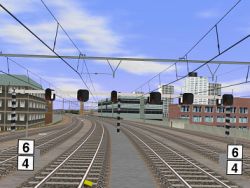 What exactly do train drivers look at when approaching portal signals? ProRail and the National Aerospace Laboratory (NLR) have conducted joint research in order to study the responses and behaviour of train drivers.
What exactly do train drivers look at when approaching portal signals? ProRail and the National Aerospace Laboratory (NLR) have conducted joint research in order to study the responses and behaviour of train drivers.
Train drivers derive their information from the outside world, while pilots get during flight most information from their cockpit displays. Despite this difference, the same methods used for mapping pilot behaviour are also suitable for studying the behaviour of train drivers.
In this research project, eye-tracking equipment and simulator studies were used, although these research methods were still relatively new for ProRail. The NLR has experience with such systems from studies it has conducted into the responses and behavior of pilots and air traffic controllers, in which the objective is to create better and safer work environments and procedures.
In this joint research project, NLR assisted ProRail in acquiring the eye-tracking equipment and applying this equipment in a NS train simulator. ProRail wanted to determine if eye-tracking, in combination with other research methods used by the NLR, is suitable for answering their own research questions, such as, for example: how do train drivers react to new designs of portal signals, bridges or stations? And where do train drivers look when approaching a portal signal?
As a case study, a research project was set up involving the portal signal situated between Eindhoven Beukenlaan and Eindhoven Central station, which, in the past, was a location where a number of trains have passed red signals. The behaviour of the train drivers when passing that signal was studied (in the simulator and in actual practice).
ProRail is enthusiastic about the insights gleaned from this method of studying the behavior of train drivers, as it helps provide answers to their own particular research questions. ProRail can also use this method to set up new constructions on railway lines in order to preemptively test the reactions of train drivers in the simulator. As a recent follow up to this research, a brief study was also made of how Thalys train drivers look at signals and other signposts when approaching at high speeds.
A next step in this project is to study the train dispatchers, with the research focusing on how the dispatchers worked prior to the introduction of a new procedure for dispatching trains at Utrecht Central station, and how they worked following the introduction of the new procedure. The research findings are now being compared.

